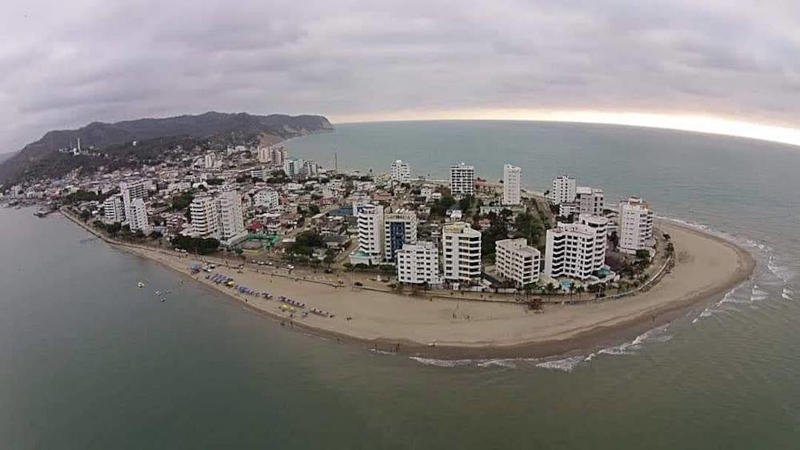
Bahía de Caráquez and Canoa Coastal Treasures of Ecuador’s Manabí Province
Bahía de Caráquez and Canoa are two captivating coastal towns in Ecuador’s Manabí Province, offering a perfect blend of natural beauty, affordable living, and vibrant culture along the Pacific shore. Bahía de Caráquez, the capital of Sucre Canton, boasts solid infrastructure, an eco-friendly ethos, and a health-conscious community, while Canoa, just 20 kilometers north, lures adventurers with its pristine white sand beaches and world-class surfing waves, easily accessible by a $0.80 bus or a $10 taxi from Bahía. Together, Bahía de Caráquez and Canoa showcase the best of Ecuador’s coastal lifestyle—scenic, laid-back, and budget-friendly—making them must-visit destinations for travelers and expats alike. Let’s dive into the facts, features, and unique charm of this dynamic duo.
Bahía de Caráquez: The Eco-Friendly Capital of Sucre Canton
Bahía de Caráquez is the administrative hub of Sucre Canton, a region with a population of approximately 57,159 according to the 2022 census. The town itself has around 22,209 residents, predominantly mestizos with notable Italian and Lebanese descent from early 20th-century immigration. Located on a sandy peninsula at the mouth of the Chone River, Bahía earned its “eco-city” title in 1999. This transformation embraced sustainability with initiatives like recycling, organic farming, and a ban on plastic bags, shaping its modern identity.

The town’s infrastructure is impressive, featuring well-paved roads, reliable utilities, and the Los Caras Bridge, opened in 2010, which connects Bahía to San Vicente. Spanning 1,980 meters (6,496 feet), it’s the longest bridge in Ecuador, slashing travel time across the Chone River and boosting regional connectivity. Healthcare is another strength, with the Miguel H. Alcívar Hospital providing quality services, making Bahía attractive to retirees and expats.

Industry in Bahía centers on government administration, commerce, and agriculture. As the cantonal capital, it hosts municipal offices overseeing Sucre’s affairs. Farming thrives in the fertile Chone River valley, producing bananas, cacao, and rice, while shrimp farming dominates the economy. The bay’s 6,000 hectares of shrimp pools include pioneering organic farms, supporting Ecuador’s status as a global shrimp leader. Small-scale cattle, pig, and poultry farming also contribute to rural livelihoods.
Canoa: The Surfing Paradise Next Door

Canoa, with a population of about 3,000, offers a quieter contrast. This fishing village turned tourist hub relies on its 17-kilometer white sand beach and vibrant surf scene. While lacking Bahía’s infrastructure, Canoa’s economy thrives on tourism, fishing, and small-scale farming. Beachfront businesses—hostels, eateries, and surf shops—cater to visitors, especially from December to February when waves peak.
White Sand Beaches and Surfing
Bahía’s calm, white sand beaches along the bay are perfect for swimming, with a small point break near town offering modest waves for beginner surfers. The Pacific side is rougher but less consistent. Canoa, however, is a surfer’s paradise. Its long beach delivers bigger, more reliable waves, especially at high tide, drawing enthusiasts to spots like the northern cliffs. Surf schools make it accessible for all levels, with the dramatic coastal scenery enhancing the experience.
A Health-Minded Community in Bahía
Bahía’s health-conscious culture shines through its active clubs. Running groups utilize the flat malecón, while swimming clubs enjoy the bay’s tranquil waters. Social and fitness groups like the Bahía Women’s Club and yoga classes foster community wellness. This mindset extends to food, with fresh seafood dishes like encebollado—a fish soup with yuca—and ceviche—lime-marinated fish—highlighting healthy, local ingredients. Markets brim with affordable produce, reinforcing a nutritious, budget-friendly diet.


Bahía de Caráquez and Canoa Cost of Living: Among Ecuador’s Lowest
Bahía and Canoa offer some of Ecuador’s cheapest coastal living. In Bahía, a couple can live comfortably on $7,00 to $1,400 monthly, with one-bedroom apartments renting for $250-$500 and two-bedrooms at $300-$700. Utilities, food, and transport are inexpensive, thanks to subsidized fuel (around $1.50 per gallon). A single person can thrive on $800 monthly. Canoa’s costs are similar, with basic rentals at $300-$500 and meals costing just a few dollars, appealing to those seeking simplicity.

Here is a list of businesses in Bahía de Caráquez.
Incredible Weather Year-Round in Bahía de Caráquez and Canoa
The weather in both towns is a coastal delight. In a dry tropical zone south of the equator, Bahía and Canoa enjoy low humidity and temperatures of 25°C to 29°C (77°F to 84°F) during the dry season (May to November). The wet season (December to April) brings occasional rain but rarely disrupts life, with slightly warmer days. Warm Pacific waters and steady breezes make it ideal for beach-going, surfing, or paragliding year-round.
Bahía de Caráquez and Canoa Interesting Facts and Final Thoughts
Bahía’s eco-city status and organic shrimp farms are globally recognized, while the Los Caras Bridge stands as an engineering marvel, enhancing access along the Spondylus Route. Bahia’s proximity to Isla Corazón—a mangrove island with thriving bird-life—offers eco-tourism. Both towns are a five-hour bus ride from Quito, with the bridge cutting local travel to 15 minutes.

Bahía de Caráquez blends infrastructure, health focus, and sustainability, while Canoa offers raw beaches and surf culture. Whether you seek affordable living, outdoor adventure, or fresh ceviche under the sun, this Manabí duo delivers an unbeatable coastal experience.




